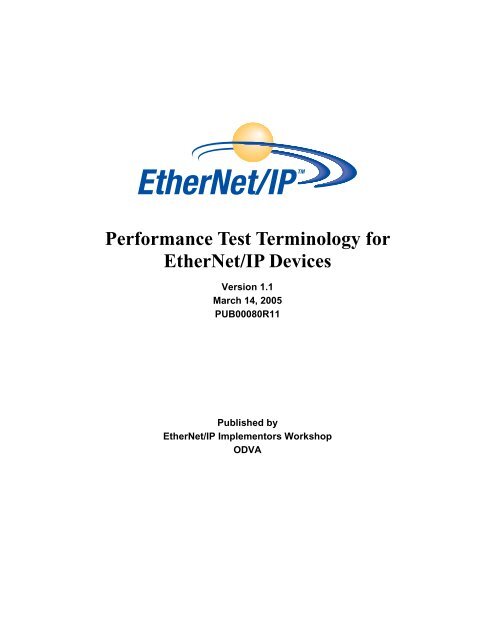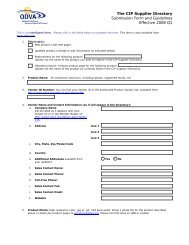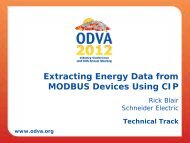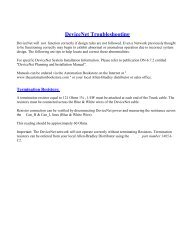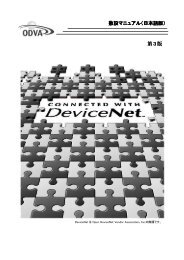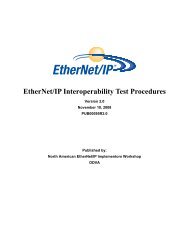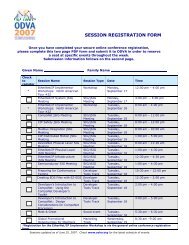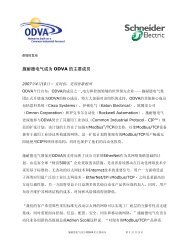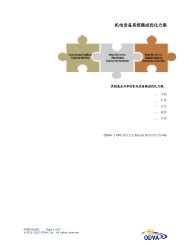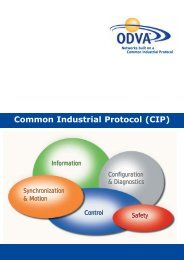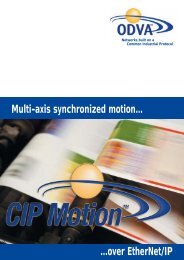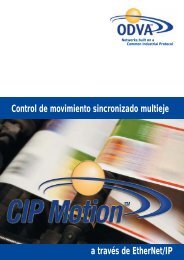Performance Test Terminology for EtherNet/IP Devices - ODVA
Performance Test Terminology for EtherNet/IP Devices - ODVA
Performance Test Terminology for EtherNet/IP Devices - ODVA
- No tags were found...
You also want an ePaper? Increase the reach of your titles
YUMPU automatically turns print PDFs into web optimized ePapers that Google loves.
<strong>Per<strong>for</strong>mance</strong> <strong>Test</strong> <strong>Terminology</strong> <strong>for</strong><strong>EtherNet</strong>/<strong>IP</strong> <strong>Devices</strong>Version 1.1March 14, 2005PUB00080R11Published by<strong>EtherNet</strong>/<strong>IP</strong> Implementors Workshop<strong>ODVA</strong>
<strong>Per<strong>for</strong>mance</strong> <strong>Test</strong> <strong>Terminology</strong> <strong>for</strong> <strong>EtherNet</strong>/<strong>IP</strong> <strong>Devices</strong>Document Revision LogRevision Sections Remarks Date Author(s)0.7 Initial Draft 7/15/04 <strong>EtherNet</strong>/<strong>IP</strong><strong>Per<strong>for</strong>mance</strong>Workgroup0.8 2.7, 4.x (2.7) Removed text referring to 9/14/04 James Gilsinnthroughput being tested with nobackground traffic.(4.x) Split out definitions ofLoaded, Unloaded, Within-Spec,and Outside-Spec.Updates made per Workshop #13comments1.0 First release after Workshop #13 9/16/04 James Gilsinnapproval1.1 Various Updated document perrecommendations from<strong>EtherNet</strong>/<strong>IP</strong> <strong>Per<strong>for</strong>mance</strong>Workgroup.03/14/05 James GilsinnMarch 14, 2005 ii PUB00080R11
<strong>Per<strong>for</strong>mance</strong> <strong>Test</strong> <strong>Terminology</strong> <strong>for</strong> <strong>EtherNet</strong>/<strong>IP</strong> <strong>Devices</strong>AbstractThis document discusses and defines a number of terms that are used in describing per<strong>for</strong>mancetests and the results <strong>for</strong> <strong>EtherNet</strong>/<strong>IP</strong> devices. The terms and definitions presented in thisdocument will be used in additional documents to describe per<strong>for</strong>mance tests and the suggested<strong>for</strong>mat in reporting the results <strong>for</strong> these tests. This document is a product of the <strong>EtherNet</strong>/<strong>IP</strong><strong>Per<strong>for</strong>mance</strong> Workgroup of the Open DeviceNet Vendor Association (<strong>ODVA</strong>) <strong>EtherNet</strong>/<strong>IP</strong>Implementors Workshop.Table of Contents1 Introduction .......................................................................................................12 Metrics................................................................................................................22.1 Term (Definition Format) ............................................................................................... 22.2 Action Latency................................................................................................................ 22.3 Jitter/Variability .............................................................................................................. 32.4 Latency............................................................................................................................ 32.5 Overload Behavior.......................................................................................................... 42.6 Response Latency (a.k.a. Response Time) ..................................................................... 42.7 Throughput...................................................................................................................... 53 Types of Equipment ..........................................................................................63.1 Term (Definition Format) ............................................................................................... 63.2 Device Under <strong>Test</strong> (DUT) .............................................................................................. 63.3 Network Analyzer........................................................................................................... 63.4 Network Infrastructure Equipment ................................................................................. 73.5 Protocol Analyzer ...........................................................................................................73.6 <strong>Test</strong> Equipment ............................................................................................................... 83.7 Traffic Generator ............................................................................................................ 84 Other Terms ......................................................................................................94.1 Unloaded......................................................................................................................... 94.2 Loaded............................................................................................................................. 94.3 Within-Spec .................................................................................................................... 94.4 Outside-Spec................................................................................................................... 95 <strong>EtherNet</strong>/<strong>IP</strong> <strong>Per<strong>for</strong>mance</strong> Workgroup Members........................................106 Acknowledgments ...........................................................................................107 References ........................................................................................................101 IntroductionThe specifications used to define the per<strong>for</strong>mance characteristics of network devices are oftenwritten in different ways from different vendors. This makes it difficult <strong>for</strong> users to comparesimilar devices from without doing painstaking searching through manuals or hours contactingengineers from the vendors to determine how the different per<strong>for</strong>mance characteristics relate.This document and follow-up documents attempt to define a specific set of terminology and teststhat vendors can use to measure and report the per<strong>for</strong>mance characteristics of network devices.March 14, 2005 1 PUB00080R11
<strong>Per<strong>for</strong>mance</strong> <strong>Test</strong> <strong>Terminology</strong> <strong>for</strong> <strong>EtherNet</strong>/<strong>IP</strong> <strong>Devices</strong>This will provide the user comparable data from different vendors with which to evaluate thesedevices. [1]2 Metrics2.1 Term (Definition Format)Definition:The specific definition <strong>for</strong> the term.Discussion:A brief discussion of the term, its application, and any restrictions on themeasurement procedure.Measurement Units:The units used to report measurements <strong>for</strong> this term, if applicable. When possible,the International System of Units (SI) will used.Issues:A discussion of issues or conditions that relate to the term.See Also:A list of other terms or references that relate to this term or its discussion.2.2 Action LatencyDefinition:The closed-loop latency of a device to process a command and return a desiredphysical output or vice versa.Discussion:Action Latency measures the latency <strong>for</strong> a device to either process a networkcommand and produce a physical output or process a physical input and produce anetwork packet. An example might be <strong>for</strong> a device to change a digital output fromoff (logical 0) to on (logical 1). The Action Latency would be calculated as the timedifference between the last bit of the command packet received by the DUT (or thelast bit of the last command packet if the command requires more than one packet)and the physical output being turned on. A similar example might be to measure thetime difference <strong>for</strong> a physical input to a device to be changed from off to on and thefirst bit of the network packet received by the test equipment.Measurement Units:Nano-Seconds (ns)Issues:Action Latency <strong>for</strong> <strong>EtherNet</strong>/<strong>IP</strong> devices may be affected by the Requested PacketInterval (RPI) or Actual Packet Interval (API). Since data is only sent over the wireat specific rates, the Action Latency <strong>for</strong> an input device would be affected by the APIof the device. Output devices may be less affected by the API value, since they areMarch 14, 2005 2 PUB00080R11
<strong>Per<strong>for</strong>mance</strong> <strong>Test</strong> <strong>Terminology</strong> <strong>for</strong> <strong>EtherNet</strong>/<strong>IP</strong> <strong>Devices</strong>likely to send the output as quickly as they can after receiving the command. (<strong>Test</strong>swill have to be conducted to determine the validity of this <strong>for</strong> individual devices.)See Also:LatencyResponse Latency2.3 Jitter/VariabilityDefinition:The amount of change in the measured times <strong>for</strong> a series of events.Discussion:This term is a modifier <strong>for</strong> other terms, i.e. Throughput Variability or Latency Jitter.(When used separately, the terms Jitter or Variability usually refer to ThroughputJitter/Variability.) This measure includes the difference between the minimum andmaximum values as well as the standard deviation of the measured times.Measurement Units:Nano-Seconds (ns)Issues:NoneSee Also:Reference [1]2.4 LatencyDefinition:The time interval between a message being sent to a device and a correspondingevent occurring.Discussion:Latency shows the time delay <strong>for</strong> a device to actually process data. A device may beasked to process a command and return some data or may be commanded to per<strong>for</strong>msome action. The type of action will be determined by the test data required. Whenthe DUT is receiving a network packet, latency is calculated as the time differencebetween the last bit of the message packet received by the DUT (or the last bit of thelast command packet if the command requires more than one packet) and thecorresponding event occurring. When the DUT is sending a network packet, latencyis calculated as the time difference between the event occurring and the first bit ofthe message packet sent by the DUT.Measurement Units:Nano-Seconds (ns)Issues:NoneMarch 14, 2005 3 PUB00080R11
<strong>Per<strong>for</strong>mance</strong> <strong>Test</strong> <strong>Terminology</strong> <strong>for</strong> <strong>EtherNet</strong>/<strong>IP</strong> <strong>Devices</strong>See Also:Action LatencyResponse LatencyReference [1]2.5 Overload BehaviorDefinition:A qualitative description of the behavior of a device in an overload state.Discussion:Overload states exist when the device’s internal resources either receive too muchin<strong>for</strong>mation to process or receive enough bad in<strong>for</strong>mation to cause the device to gointo a state other than its normal run mode.Data recorded <strong>for</strong> overload states should:- Describe the device behavior when its resources are exhausted.- Describe the system management response in an overload state.- Describe the device recovery from an overload state.Measurement Units:NoneIssues:NoneSee Also:Reference [1]2.6 Response Latency (a.k.a. Response Time)Definition:The closed-loop latency of a device to process a command and respond to it.Discussion:Response Latency measures the latency <strong>for</strong> a device to process a network commandand return a value from memory. This should represent the minimum latency <strong>for</strong> adevice to process a command through its network stack. An example might be <strong>for</strong> adevice to return a value from the <strong>EtherNet</strong>/<strong>IP</strong> identity object. Since the identityobject is a specific <strong>EtherNet</strong>/<strong>IP</strong> and C<strong>IP</strong> concept, the command would have to beprocessed through the entire communications stack to the application layer. Theprimary per<strong>for</strong>mance concern is <strong>for</strong> real-time I/O response time, so the actual objectand values requested from the device will have to be determined be<strong>for</strong>e the test isconducted. The Response Latency is calculated as the time difference between thelast bit of the command packet leaving the test equipment (or the last bit of the lastcommand packet if the command requires more than one packet) and the first bit ofthe response packet received by the test equipment.Measurement Units:Nano-Seconds (ns)March 14, 2005 4 PUB00080R11
<strong>Per<strong>for</strong>mance</strong> <strong>Test</strong> <strong>Terminology</strong> <strong>for</strong> <strong>EtherNet</strong>/<strong>IP</strong> <strong>Devices</strong>Issues:Response Latency <strong>for</strong> <strong>EtherNet</strong>/<strong>IP</strong> devices may be affected by the Requested PacketInterval (RPI) or Actual Packet Interval (API). Since data is only sent over the wireat specific rates, the Response Latency <strong>for</strong> an input device would be affected by theAPI of the device. (<strong>Test</strong>s will have to be conducted to determine the validity of this.)See Also:Action LatencyLatency2.7 ThroughputDefinition:The maximum continuous traffic rate that a device can send/receive withoutdropping a single packet.Discussion:This metric determines the maximum amount of traffic a device is capable ofproducing at one time. The metric should produce a 2D matrix of results <strong>for</strong> the datacollected during the series of tests conducted.This metric gives the user an understanding of how much data the device is capableof actually producing or consuming. It shows the difference in the data rates fromthe device in contrast to the data rates of the network interface (10/100 Mbits/s).Measurement Units:Frames per second (s) @ a given frame size (# of bits/bytes) or Bits/Bytes per second(s)Issues:The amount of data produced or consumed by the device will be dependant on thenumber of connections the device is capable of handling and the RPI values <strong>for</strong> thoseconnections. An example would be a device that is capable of handling 4connections at a RPI rate of 10 ms and 8 connections at 50 ms all at a frame size of128 bytes.Throughput =Throughput = 560See Also:Reference [1]bytes[( 4 frames × 1 ) + ( 8 frames × 1 )]@ ( 128 frame)framess10ms@128bytesframe= 7168050ms= 573440bytessbitssMarch 14, 2005 5 PUB00080R11
<strong>Per<strong>for</strong>mance</strong> <strong>Test</strong> <strong>Terminology</strong> <strong>for</strong> <strong>EtherNet</strong>/<strong>IP</strong> <strong>Devices</strong>3 Types of Equipment3.1 Term (Definition Format) *DefinitionThe specific definition <strong>for</strong> the term.Discussion:A brief discussion of the term, its application, and any other pertinent in<strong>for</strong>mation.Examples:Examples of the equipment type. These examples may give manufacturer or productnames.See Also:List of other terms or references that relate to this term or its discussion.3.2 Device Under <strong>Test</strong> (DUT)Definition:The device to be tested.Discussion:The device should be con<strong>for</strong>mance tested to the <strong>EtherNet</strong>/<strong>IP</strong> specification be<strong>for</strong>ebeing subjected to per<strong>for</strong>mance tests.Examples:Programmable Logic Controller (PLC)Distributed/Remote Input/Output BlockSee Also:Reference [1]3.3 Network AnalyzerDefinition:A device capable of recording network packets and analyzing the timing of thosepackets.Discussion:These devices may be software or hardware based. They may be combined withProtocol Analyzers to <strong>for</strong>m a more generic solution.If the network analyzer is software based, the timing of the packets is subject towhatever limits exist <strong>for</strong> the hardware plat<strong>for</strong>m. On a Microsoft Windows plat<strong>for</strong>m,timing resolutions may be as high as 150 ms depending on how the software is* Commercial equipment and software referred to in this document are identified <strong>for</strong> in<strong>for</strong>mational purposes only,and does not imply recommendation of or endorsement by <strong>ODVA</strong>, the National Institute of Standards andTechnology, HRL, or the other organizations represented in this document, nor does it imply that the products soidentified are the best available <strong>for</strong> the purpose.March 14, 2005 6 PUB00080R11
<strong>Per<strong>for</strong>mance</strong> <strong>Test</strong> <strong>Terminology</strong> <strong>for</strong> <strong>EtherNet</strong>/<strong>IP</strong> <strong>Devices</strong>configured to use the system’s clock. However, most of the software packages areconfigured to get near millisecond resolution of their timing signals.Hardware network analyzers are usually dedicated pieces of hardware specificallydesigned to facilitate per<strong>for</strong>mance testing and network troubleshooting. They havegreater capabilities, higher resolution timing, and more flexibility. Many times,these devices have removable network interface cards that allow them to be used <strong>for</strong>networks other than Ethernet. In addition, they usually have the capability to analyzenetwork packets at higher layers in the ISO/OSI 7-layer Reference Model abovelayer 2 (Data Link layer). Some of the devices are capable of full 7 layer operation.Examples:Frontline <strong>Test</strong> Equipment’s NetDecoderSpirent’s SmartBitsIxia’s 400T SystemSee Also:Protocol AnalyzerTraffic Generators<strong>Test</strong> Equipment3.4 Network Infrastructure EquipmentDefinition:Any device associated with connecting the <strong>Test</strong> Equipment to the DUT over thenetwork.Discussion:Network infrastructure equipment is a necessary piece of the test but should notimpede the test in any way. The network infrastructure equipment should beper<strong>for</strong>mance tested prior to testing any other devices. Any jitter or latenciesassociated with the infrastructure equipment can be taken into account whenanalyzing the results from the DUT.Examples:Ethernet SwitchEthernet HubNetwork RouterSee Also:Device Under <strong>Test</strong> (DUT)<strong>Test</strong> Equipment3.5 Protocol AnalyzerDefinition:A device capable of decoding and analyzing network packets.March 14, 2005 7 PUB00080R11
<strong>Per<strong>for</strong>mance</strong> <strong>Test</strong> <strong>Terminology</strong> <strong>for</strong> <strong>EtherNet</strong>/<strong>IP</strong> <strong>Devices</strong>Discussion:Protocol Analyzers are usually software packages capable of decoding all theprotocols in a network packet. They allow the individual portions of the packet to beanalyzed separately and in protocol specific terms instead of trying to interpret thebits or hex-code equivalent. They are often bundled with network analyzerfunctionality so they can capture packets and analyze the timing of the individualpackets.Examples:Frontline <strong>Test</strong> Equipment’s NetDecoderEtherealSee Also:Network Analyzer3.6 <strong>Test</strong> EquipmentDefinition:Any equipment used during the per<strong>for</strong>mance tests to stimulate, record, or control thetest.Discussion:Any device used during the test that is not specifically the DUT or NetworkInfrastructure Equipment is considered <strong>Test</strong> Equipment. <strong>Test</strong> equipment may consistof more than one device if a complex test is to be per<strong>for</strong>med.Examples:Network AnalyzerTraffic GeneratorProtocol AnalyzerProgrammable Logic Controller (PLC)Distributed/Remote Input/Output BlockLaptop ComputerSee Also:Traffic GeneratorNetwork AnalyzerProtocol Analyzer3.7 Traffic GeneratorDefinition:A device capable of generating network packets during the test.Discussion:Traffic generators will control the flow of traffic during the test. They provide thestimulus that other devices react to. These devices may produce industrial specificnetwork traffic or background traffic used to determine the per<strong>for</strong>mance of the DUT.Be<strong>for</strong>e any test is conducted, the per<strong>for</strong>mance of the traffic generator must beunderstood. If it is a dedicated traffic generating device, the per<strong>for</strong>mance is probablyMarch 14, 2005 8 PUB00080R11
<strong>Per<strong>for</strong>mance</strong> <strong>Test</strong> <strong>Terminology</strong> <strong>for</strong> <strong>EtherNet</strong>/<strong>IP</strong> <strong>Devices</strong>orders of magnitude better than the DUT, which should not affect the results of thetests. Other devices that do not include such dedicated hardware or are themselvesindustrial devices may have per<strong>for</strong>mance characteristics that are similar to the DUT.These per<strong>for</strong>mance characteristics need to be accounted <strong>for</strong> when analyzing theresults of any test conducted.Examples:Spirent’s SmartBitsIxia’s 400T SystemProgrammable Logic Controller (PLC)Distributed/Remote Input/Output BlockLaptop ComputerSee Also:<strong>Test</strong> Equipment4 Other Terms4.1 UnloadedThe test is conducted with no background traffic on the network.4.2 LoadedThe test is conducted with background applied to the network.4.3 Within-SpecThe test is conducted within the manufacturer’s specifications.4.4 Outside-SpecThe test is conducted outside the manufacturer’s specifications.March 14, 2005 9 PUB00080R11
<strong>Per<strong>for</strong>mance</strong> <strong>Test</strong> <strong>Terminology</strong> <strong>for</strong> <strong>EtherNet</strong>/<strong>IP</strong> <strong>Devices</strong>5 <strong>EtherNet</strong>/<strong>IP</strong> <strong>Per<strong>for</strong>mance</strong> Workgroup Members• Brian Batke, Rockwell Automation, babatke@ra.rockwell.com• James Gilsinn, National Institute of Standards & Technology (NIST),james.gilsinn@nist.gov• Kevin Martin, HRL Laboratories, martin@hrl.com• Anatoly Moldovansky, Rockwell Automation, amoldovansky@ra.rockwell.com• Mark Weisenborn, Frontline <strong>Test</strong> Equipment, mweisenborn@fte.com• Gary Workman, General Motors, gary.c.workman@gm.com6 AcknowledgmentsThe <strong>EtherNet</strong>/<strong>IP</strong> <strong>Per<strong>for</strong>mance</strong> Workgroup would like to thank the following additional peoplewho provided input to this document:• Scott Bradner, Harvard University7 References[1] Bradner, S. ed., “Benchmarking <strong>Terminology</strong> <strong>for</strong> Network Interconnection <strong>Devices</strong>,” RFC1242, July 1991, Internet Engineering Task Force (IETF),http://www.ietf.org/rfc/rfc1242.txt .[2] Bradner, S., McQuaid, J., ed., “Benchmarking Methodology <strong>for</strong> Network Interconnection<strong>Devices</strong>,” RFC 2544, March 1999, Internet Engineering Task Force (IETF),http://www.ietf.org/rfc/rfc2544.txt .[3] <strong>EtherNet</strong>/<strong>IP</strong> Specification, version 1.0, June 5, 2001, Open DeviceNet Vendor Association(<strong>ODVA</strong>), http://www.odva.org/ .March 14, 2005 10 PUB00080R11


